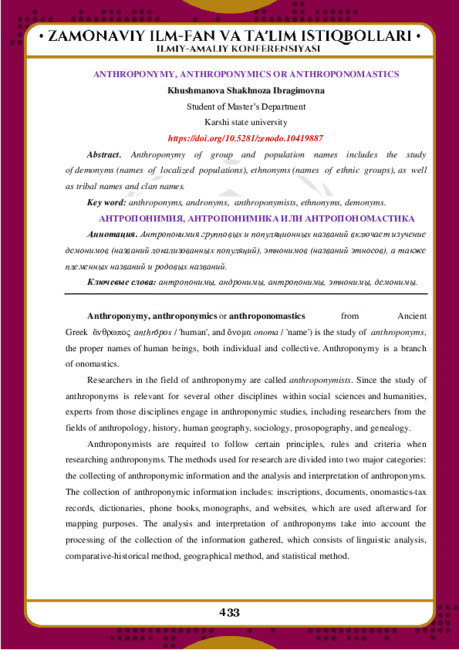
433
ANTHROPONYMY, ANTHROPONYMICS OR ANTHROPONOMASTICS
Khushmanova Shakhnoza Ibragimovna
Student of Master’s Department
Karshi state university
https://doi.org/10.5281/zenodo.10419887
Abstract.
Anthroponymy of group and population names includes the study
of demonyms (names of localized populations), ethnonyms (names of ethnic groups), as well
as tribal names and clan names.
Key word:
anthroponyms, andronyms, anthroponymists, ethnonyms, demonyms.
АНТРОПОНИМИЯ, АНТРОПОНИМИКА ИЛИ АНТРОПОНОМАСТИКА
Аннотация.
Антропонимия групповых и популяционных названий включает изучение
демонимов (названий локализованных популяций), этнонимов (названий этносов), а также
племенных названий и родовых названий.
Ключевые слова:
антропонимы, андронимы, антропонимы, этнонимы, демонимы.
Anthroponymy,
anthroponymics
or
anthroponomastics
from
Greek ἄνθρωπος
anthrōpos
/ 'human', and ὄνομα
onoma
/ 'name') is the study of
anthroponyms
,
the proper names of human beings, both individual and collective. Anthroponymy is a branch
of onomastics.
Researchers in the field of anthroponymy are called
anthroponymists
. Since the study of
anthroponyms is relevant for several other disciplines within social sciences and humanities,
experts from those disciplines engage in anthroponymic studies, including researchers from the
fields of anthropology, history, human geography, sociology, prosopography, and genealogy.
Anthroponymists are required to follow certain principles, rules and criteria when
researching anthroponyms. The methods used for research are divided into two major categories:
the collecting of anthroponymic information and the analysis and interpretation of anthroponyms.
The collection of anthroponymic information includes: inscriptions, documents, onomastics-tax
records, dictionaries, phone books, monographs, and websites, which are used afterward for
mapping purposes. The analysis and interpretation of anthroponyms take into account the
processing of the collection of the information gathered, which consists of linguistic analysis,
comparative-historical method, geographical method, and statistical method.

434
Anthroponyms of individuals can also be classified according to gender. Names of human
males are called
andronyms
(from Ancient Greek ἀνήρ / man, and ὄνομα / name), while names of
human females are called
gynonyms
(from Ancient Greek γυνή / woman, and ὄνομα / name).
Anthroponymy of group and population names includes the study of demonyms (names of
localized populations), ethnonyms (names of ethnic groups),
as well as tribal names and clan
There are several specific terms and processes related to anthroponymy, like:
anthroponymization
, a process when an anthroponym is formed from an apellative,
like when a surname is created from the name of one’s occupation, thus forming
an occupational surname. Such surnames are common in most languages, including
(from smith),
(from miller),
(from thatcher),
(from potter).
deanthroponymization
, a process when an anthroponym becomes an apellative, like
when the surname of the inventor Louis Braille was used to create a name for the writing
system for the visually impaired persons (braille).
transonymization
of anthroponyms into toponyms, a process when a human proper
name is used to form a toponym (proper name of a locality; place name), thus creating
, like when the name of Alexander the Great was used to create
several
astionyms
(city names), including name for the newly created city of Alexandria in the
ancient Hellenistic Egypt, or when the surname of Christopher Columbus was used to create
several
choronyms
(region names), including names for Southamerican state of Colombia, and
Canadian province of British Columbia.
transonymization
of toponyms into anthroponyms, a process when toponyms (place
names)
are
used
to
form
human
names
(anthroponyms),
thus
creating
various
topoanthroponyms
. Many surnames are created in that way, and they are known
as toponymic
Most demonyms (names
for
localized
populations)
are
topoanthroponyms
by formation, since they are usually created from toponyms, and also
some ethnonyms are
topoanthroponyms
too (those that are formed from toponyms, and thus
referred to as
topoethnonyms
). For example, geographic designations for the region of
Black
Mountain
(Montenegro) and frontier region of
Ukraina
(Ukraine) were used to create not only
demonyms for general populations for those regions, but also ethnonyms for modern ethnic
Montenegrins and ethnic Ukrainians.

435
REFERENCES
1.
Barolini, Teodolinda, ed. (2005). Medieval Constructions in Gender And Identity: Essays in
Honor of Joan M. Ferrante. Tempe: Arizona Center for Medieval and Renaissance
Studies. ISBN 9780866983372.
2.
Bourin, Monique; Martínez Sopena, Pascual, eds. (2010). Anthroponymie et migrations
dans la chrétienté médiévale [Anthroponymy and Migrations in Medieval Christianity].
Madrid: Casa de Velázquez. ISBN 9788496820333.
3.
Bruck, Gabriele vom; Bodenhorn, Barbara, eds. (2009) [2006]. An Anthropology of Names
and Naming (2nd ed.). Cambridge: Cambridge University Press.
4.
Danver, Steven L., ed. (2015). Native Peoples of the World: An Encyclopedia of Groups,
London
and
New
York:
Routledge. ISBN 9781317464006.
5.
Fossier, Robert (2010). The Axe and the Oath: Ordinary Life in the Middle Ages. Princeton,
NJ: Princeton University Press. ISBN 9781400836147.
6.
Fraser, Peter M. (2000). "Ethnics as Personal Names". Greek Personal Names: Their Value
as Evidence (PDF). Oxford: Oxford University Press. pp. 149–157. Archived from the
original (PDF) on 2019-10-18. Retrieved 2019-10-21.
7.
Reis, Levilson C. (2013). "The medieval forms and meanings of Francois: The political and
ethnonym". French
Studies
Bulletin.
34
(3):
58–
61. doi:10.1093/frebul/ktt019.
8.
Roberts, Michael (2017). "The Semantics of Demonyms in English". The Semantics of
Nouns. Oxford: Oxford University Press. pp. 205–220. ISBN 978-0-19-873672-1.
9.
Common Similarities and Differences of Uzbek and English Fairy Tales KS Jalilovna
European Journal of Innovation in Nonformal Education 2 (1), 366-369
10.
PHILOSOPHICAL ASPECTS OF GLOBALIZATION S Khalilova Gospodarka i
Innowacje. 28, 6-11
11.
COMPARATIVE ANALYSIS OF UZBEK AND ENGLISH FAIRY TALES KS Jalilovna
IJTIMOIY FANLARDA INNOVASIYA ONLAYN ILMIY JURNALI, 80-83
A CASE STUDY ON VOCABULARY LEARNING THROUGH READING FAIRY
TALES KS Jalilovna E-Conference Globe, 5-6
THE VALUE OF THE HERITAGE OF ABU ALI IBN SINA IN THE DEVELOPMENT
OF YOUTH EDUCATION S Khalilova American Journal of Research in Humanities and
Social Sciences 14, 146-151

436
14.
The act of performance of fairy tales and traditions of storytelling S Khalilova
ACADEMICIA an International Multidisciplinary research Journal, 72-75
15.
Common features between the genres of English and Uzbek folklore S Khalilova Asian
Journal of Multidimensional Research, 323-327





